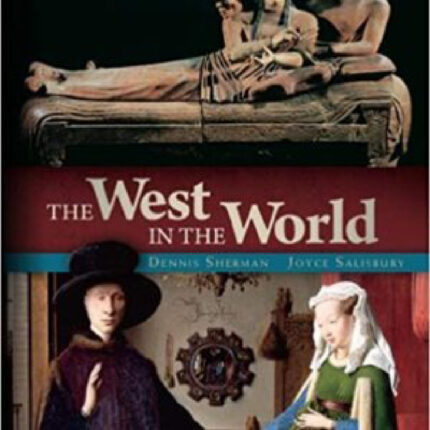CHAPTER 11: The Peculiar Institution
MULTIPLE CHOICE
1. Frederick Douglass argued that:
a. slaves were truer to the principles of the Declaration of Independence than were most white Americans.
b. the United States should adopt a gradual emancipation plan that would eliminate slavery within forty years.
c. free blacks would be better off if they moved to Liberia, where a colony of former American slaves had been founded.
d. blacks should not serve in the U.S. army during the Civil War because of the racial discrimination they faced.
e. free African-Americans should “let down their buckets where they were” and accept inequality, at least for a period of time.
ANS: A DIF: Moderate REF: p. 312
OBJ: 2. Identify the legal and material constraints on slaves’ lives and work.
TOP: Civil Rights | Introduction: Frederick Douglass MSC: Remembering
2. The U.S. slave population by 1860 was approximately:
a. 1 million. d. 4 million.
b. 2 million. e. 5 million.
c. 3 million.
ANS: D DIF: Difficult REF: p. 312
OBJ: 1. Explain how slavery shaped social and economic relations in the Old South.
TOP: Geographic Issues | The Old South MSC: Remembering
3. In the nineteenth century, which product was the world’s major crop produced by slave labor?
a. Tobacco. d. Cotton.
b. Indigo. e. Rice.
c. Sorghum.
ANS: D DIF: Easy REF: p. 390
OBJ: 1. Explain how slavery shaped social and economic relations in the Old South.
TOP: Economic Development | Cotton Is King MSC: Remembering
4. On the eve of the Civil War, approximately how much of the world’s cotton supply came from the southern United States?
a. 90 percent. d. 33 percent.
b. 75 percent. e. 25 percent.
c. 50 percent.
ANS: B DIF: Difficult REF: p. 313
OBJ: 1. Explain how slavery shaped social and economic relations in the Old South.
TOP: Economic Development | Cotton Is King MSC: Remembering
5. The internal slave trade in the United States involved the movement of hundreds of thousands of enslaved persons from:
a. older states like Virginia to the Lower South.
b. Texas, Louisiana, and Mississippi to Kentucky, Virginia, and Maryland.
c. the West Indies to the Mississippi River Valley.
d. the Lower South to the Upper South.
e. the lower Mississippi River Valley to the upper Mississippi River Valley.
ANS: A DIF: Moderate REF: p. 314
OBJ: 1. Explain how slavery shaped social and economic relations in the Old South.
TOP: Civil Rights | Social History | The Second Middle Passage
MSC: Remembering
6. What economic effect did southern slavery have on the North?
a. It was minimal, which explains why northerners opposed slavery.
b. Many northerners profited from investing in real-estate partnerships that controlled southern plantations.
c. A few New York shipping companies benefited from slavery, but the institution had little effect otherwise.
d. Southern slavery helped finance industrialization and internal improvements in the North.
e. Southern slavery drained resources from the North and helped keep the whole nation in a depression during the 1850s.
ANS: D DIF: Moderate REF: p. 314
OBJ: 1. Explain how slavery shaped social and economic relations in the Old South.
TOP: Economic Development | Slavery and the Nation MSC: Understanding
7. Why could someone argue that the North was complicit in the expansion of slavery?
a. Many northern states had slaves at one time.
b. Some slaves ran away to northern states.
c. Some slaveholders were originally from the North.
d. Most in the North wanted to reopen the importation of slaves.
e. Northern factory demand for cotton steadily increased.
ANS: E DIF: Moderate REF: p. 314
OBJ: 1. Explain how slavery shaped social and economic relations in the Old South.
TOP: Economic Development | Slavery and the Nation MSC: Analyzing
8. From 1800 to 1860, which of the following occurred to the South and its economy?
a. Southern cities, Dallas and Houston, had the most slaves.
b. The South manufactured about half of the cotton textiles.
c. Because the South was a slave society, most immigrants stayed away.
d. Slavery was not profitable for most slaveowners.
e. Southern banks’ biggest customers were small-shop craftsmen.
ANS: C DIF: Easy REF: p. 315
OBJ: 1. Explain how slavery shaped social and economic relations in the Old South.
TOP: Economic Development | The Southern Economy MSC: Understanding
9. A slave who worked primarily in cotton fields most likely lived in:
a. Richmond, Virginia. d. Jacksonville, Florida.
b. western North Carolina. e. eastern Tennessee.
c. Natchez, Mississippi.
ANS: C DIF: Difficult REF: p. 315
OBJ: 1. Explain how slavery shaped social and economic relations in the Old South.
TOP: Economic Development | Social History | The Southern Economy | The Planter Class
MSC: Applying
10. In 1860, what percentage of southern white families were in the slaveowning class?
a. 10 percent. d. 55 percent.
b. 25 percent. e. 75 percent.
c. 40 percent.
ANS: B DIF: Difficult REF: p. 316
OBJ: 1. Explain how slavery shaped social and economic relations in the Old South.
TOP: Social History | Plain Folk of the Old South MSC: Remembering













Reviews
There are no reviews yet.